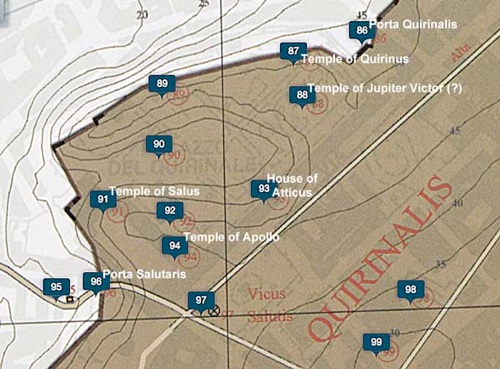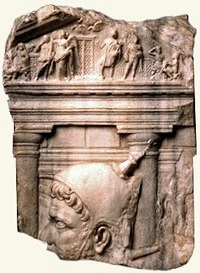Rome in the Early Republic (509 - 241 BC)
Temple of Quirinus


Rome in the Early Republic (509 - 241 BC)
Temple of Quirinus
Republican Temple of Quirinius

Location of the temple of Quirinus and the house of T. Pomponius Atticus on the Quirinal
Adapted from Digital Augustan Rome
Livy recorded that, after his victories at Aquilonia and Saepinium over the Samnites in 293 BC, towards the end of the Third Samnite War, the consul L. Papirius Cursor:
“... dedicated the temple of Quirinus. I do not find in any ancient author that it was he who vowed this temple in the crisis of a battle, and certainly he could not have completed it in so short a time; it was vowed by his [homonymous] father when dictator, and the son dedicated it when consul, and adorned it with the spoils of the enemy”, (‘‘History of Rome’’, 10: 46: 6-7).
This victory had been secured against a magnificently armed Samnite army, and:
“There was such a vast quantity of [spoils] that, not only were the temple and the Forum adorned with them, but they were distributed amongst the allied peoples and the nearest colonies to decorate their public spaces and temples”, (‘‘History of Rome’’, 10: 46: 8).
Pliny the Elder recorded that:
“The first sundial is said to have been erected among the Romans twelve years before the war with Pyrrhus, by L. Papirius Cursor, when dedicating the temple of Quirinus, which had been vowed by his father”, (‘Natural History’, 7: 60).
The pre-Julian fasti Antiates maiores record the Quirinalia (festival of Quirinus) on 17th February, and this presumably indicates the dies natalis of Papirius’ temple. As Adam Ziolkowski (referenced below, at p. 140) pointed out, the fasti Caeretani and the fasti Farnesiani both indicate that the festival was celebrated at this temple ‘in Colle’ (on the Quirinal).
Emmanuele Curti (referenced below, at p. 83) pointed out that:
“... a whole new series of buildings [were] erected [on the Quirinal] between the end of the 4th and the beginning of the 3rd centuries BC. The first impression is that the Quirinal underwent a substantial rebuilding and reorganisation of space: among the new constructions, there are the temples of:
✴Salus [dedicated in 302 BC];
✴Jupiter Victor [dedicated in 295 BC]; ... and
✴the new temple of Quirinus [dedicated in 293 BC]. ...
This sudden growth is even more intriguing if we consider that the Quirinal is the only area within the pomerium, apart from the Forum, with such a noticeable intervention during the mid-republican period.”
He suggested (at p. 85) that the Quirinal had become:
“... a new ‘residential area’, [at a time when] Rome [was] growing and [needed] to construct new urban space for the community [and, in particular], for those emerging social groups, like the new [plebeian nobility that had] fought so much in these years to disassemble the archaic structure of the Roman republic.”
Caesarian Restoration
As Beatrice Poletti (referenced below, at p. 129) observed:
“... Caesar ... could claim a close relation to Romulus on account of his Trojan genealogy and the role, in the Romulean legend, of his ancestor Julius Proculus, the patrician who supposedly witnessed Romulus’s apotheosis.”
He must, therefore, have been concerned at an event that took place soon after his brief return to Rome in 49 BC and his subsequent departure for Greece in 49 BC in pursuit of Pompey and his arm: according to Cassius Dio:
“... at the very moment that he landed at Dyrrachium [on the coast of modern Albania], he learned that he would not obtain a prosperous outcome. For [there had been a series of evil omens, including] a fire that consumed the temple of Quirinus [in Rome]... ”, (‘Roman History’, 41: 14: 3).
Cassius Dio (among other sources) recorded that the Senate granted a series of quasi-royal privileges to Julius Caesar in 45 BC. As Beatrice Poletti (referenced below, at p. 130) observed, at least three of these highlighted his familial link to Romulus:
✴“... named [Caesar] father of his country ...”, (‘Roman History’, 44: 4: 4);
✴“ ... [mandated the setting up of a likeness of him] in the Temple of Quirinus with the inscription, ‘To the Invincible God’, and another on the Capitol beside the former kings of Rome”, (‘Roman History’, 43: 45: 3); and
✴“... gave him the right to offer spolia opima, as they are called, at the temple of Jupiter Feretrius, as if he had slain some hostile general with his own hands”, (‘Roman History’, 44: 4: 3).
Stefan Weinstock (referenced below, at p. 233) observed that the third of these was:
“... an extraordinary decree, because [Caesar] had not killed an adversary in battle. It was the greatest military distinction, awarded [before that time] only to Romulus [and to two other Roman commanders who had killed an enemy leader in single combat. Caesar] was to be the fourth [to receive this distinction, although there is no surviving evidence that he did dedicate spoils in the temple].”
It is possible, however, possible that the Temple of Quirinus was restored at this time, in order to facilitate the erection there of Caesar’s statue.
Cicero seems to have heard about the statue of Caesar’s statue in the Temple of Quirinus while he was: still at Tusculum awaiting for Caesar’s return:
✴he referred to it in two letters to Atticus (whose house was on the Quirinal on 17th May
•“Clearly your house will go up in value with Caesar as a neighbour, (Letter to Atticus, 12: 48);
•“I put that in about your neighbour Caesar because I had learned of it from your letter. I would rather that he shared temples with Quirinus [the deified Romulus, who, according to some sources, had been murdered] than with Salus [the god of safety]”, (Letter to Atticus, 12: 45); and
✴on 26th May 45 BC, responding to what must have been a suggestion by Atticus that he should write a conciliatory letter to Caesar:
•“... don't you see that even that famous pupil of Aristotle [Alexander the Great], distinguished for the very best ability and the most perfect conduct, no sooner got the title of king than he became haughty, cruel, and ungovernable? Well now, do you think that this god of the procession [i.e., Caesar], this messmate of Quirinus, is likely to be gratified by temperate letters such as I should write?”, (Letter to Atticus, 13: 28).
Augustan Restoration

Fragment from an entablature, probably from the Templum Gentis Flaviae (Museo Nazionale, Rome)
It probably depicts the facade of the temple of Quirinus after its Augustan restoration of 16 BC
Copyright ©1997, 2002 Soprintendenza Archeologica di Roma & Kelsey Museum of Archaeology, Michigan
Cassius Dio recorded that, before setting out from Rome for Gaul in 16 BC, Augustus:
“... dedicated the temple of Quirinus, which he had rebuilt. I mention this because he adorned it with 76 columns, which was the exact number of the years that he lived, and thus caused some to declare [obviously in retrospect] that he had chosen this number deliberately and not by mere chance”, (‘Roman History’, 54: 19: 4).
According to Vitruvius, as rebuilt by Augustus, the temple, which he characterised as Doric, belonged to a type known as:
“The dipteros, [which] has eight columns in front and behind and ... double rows of columns around the sanctuary ... ”, (‘Ten Books of Architecture’, 3: 2: 7).
Gerhard Koeppel (referenced below) described the context in which the relief depicted above was discovered. He also pointed out(at p. 15) that it depicted the front of a temple and that its pedimental structure:
“... commemorates an event in Rome’s legendary past: Romulus taking the auspices that give him the right to found the city ... This identifies the temple as that of Quirinus, ... on the Quirinal Hill. The priest in the lower portion, with his tight-fitting cap and projecting apex, is the flamen Quirinalis.”
Peter Wiseman (referenced below, at pp. 146-9) discussed the iconography of the pediment scene in more detail. The temple depicted in the relief seems have only four of the eight columns recorded by Vitruvius, probably for the purpose of simplification.
Adam Ziolkowski (referenced below, at p. 140) pointed out the fasti Venusini record the dies natalis of the temple of Quirinus in Colle as 29th June and argued that, since Caesar had added this day to the calendar, it must have related to a re-dedication in or after this addition was made.
Read more:
B. Poletti, “Dionysius of Halicarnassus and the 'Founders' of Rome: Depicting Characters in the Roman Antiquities”, (2018), thesis of the University of Alberta
T. P. Wiseman, "Remus: A Roman Myth” (1995) Cambridge
A. Ziolkowski, “The Temples of Mid-Republican Rome”, (1992) London
G. Koeppel, “Fragments from a Domitianic Monument in Ann Arbor and Rome”,Bulletin of the Museums of Art and Archaeology, University of Michigan, 3 (1980) 15-29
S. Weinstock, “Divus Julius”, (1971) Oxford
Return to Rome in the Early Republic (509 - 241 BC)